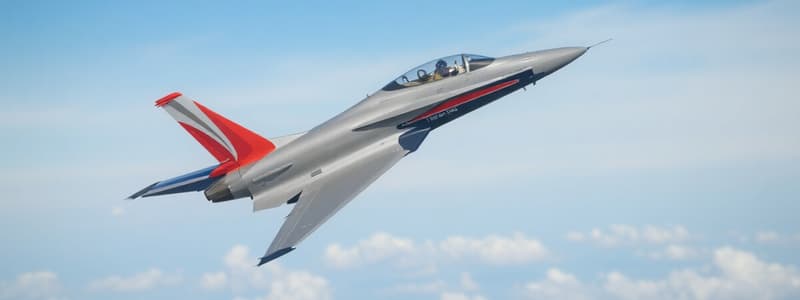Podcast
Questions and Answers
What is the maximum roll rate of the A330, depending on speed and configuration? ALT1 law
What is the maximum roll rate of the A330, depending on speed and configuration? ALT1 law
- 20 to 25°/s (correct)
- 25 to 30°/s
- 10 to 15°/s
- 15 to 20°/s
Which of the following is true about the yaw alternate law? ALT1
Which of the following is true about the yaw alternate law? ALT1
- Turn coordination is provided in all configurations.
- There is no damping function available.
- Rudder authority varies by configuration. (correct)
- It restricts roll control to ±10°.
In ALT 2 law, which protection is not available?
In ALT 2 law, which protection is not available?
- Bank angle protection (correct)
- High speed stability
- Yaw control protection
- Low speed stability
What happens in case of failure of 3 ADRs during operation ALT 2 ?
What happens in case of failure of 3 ADRs during operation ALT 2 ?
What happens to low speed stability as the aircraft approaches stall warning speed?
What happens to low speed stability as the aircraft approaches stall warning speed?
Which of the following is true regarding high speed stability in flight control systems?
Which of the following is true regarding high speed stability in flight control systems?
What change occurs to the PFD speed scale during low speed stability?
What change occurs to the PFD speed scale during low speed stability?
What remains available even when pitch attitude protection is lost?
What remains available even when pitch attitude protection is lost?
Which statement is correct regarding the lateral control in the flight control system ALT 1 ?
Which statement is correct regarding the lateral control in the flight control system ALT 1 ?
What does ROLL DIRECT LAW provide in terms of aircraft control in ALT 2 ?
What does ROLL DIRECT LAW provide in terms of aircraft control in ALT 2 ?
Flashcards
Low Speed Stability Protection
Low Speed Stability Protection
At low speed, the system uses IAS instead of angle of attack for nose-down control. This prevents the aircraft from stalling and keeps the speed above a safe minimum.
High Speed Stability Protection
High Speed Stability Protection
Above VMO/MMO, the system gives a nose-up demand to prevent exceeding speed limits.
Stall Warning Speed (Vsw)
Stall Warning Speed (Vsw)
The speed at which the system activates stall warning alerts.
Reconfiguration Control Laws - Lateral Control
Reconfiguration Control Laws - Lateral Control
Signup and view all the flashcards
Pitch Attitude Protection Loss
Pitch Attitude Protection Loss
Signup and view all the flashcards
Roll Direct Law
Roll Direct Law
Signup and view all the flashcards
Yaw Alternate Law
Yaw Alternate Law
Signup and view all the flashcards
Lateral Control Protections (ALT 2)
Lateral Control Protections (ALT 2)
Signup and view all the flashcards
ADR Failure (Lateral Control)
ADR Failure (Lateral Control)
Signup and view all the flashcards
Roll Rate (Lateral Control)
Roll Rate (Lateral Control)
Signup and view all the flashcards
ROLL DIRECT LAW (ALT2)
ROLL DIRECT LAW (ALT2)
Signup and view all the flashcards
ALT2 ROLL DIRECT LAW: Stick-to-Surface
ALT2 ROLL DIRECT LAW: Stick-to-Surface
Signup and view all the flashcards
ROLL DIRECT LAW: Gains Adjustment
ROLL DIRECT LAW: Gains Adjustment
Signup and view all the flashcards
ROLL DIRECT LAW: Maximum Roll Rate
ROLL DIRECT LAW: Maximum Roll Rate
Signup and view all the flashcards
Why is ROLL DIRECT LAW important?
Why is ROLL DIRECT LAW important?
Signup and view all the flashcards
ROLL DIRECT LAW: Gains
ROLL DIRECT LAW: Gains
Signup and view all the flashcards
What is the benefit of ROLL DIRECT LAW?
What is the benefit of ROLL DIRECT LAW?
Signup and view all the flashcards
What does 'stick-to-surface' mean in ROLL DIRECT LAW?
What does 'stick-to-surface' mean in ROLL DIRECT LAW?
Signup and view all the flashcards
Study Notes
Lateral Control - Roll Direct Law
- Provides a direct stick-to-surface position relationship
- Gains are automatically set according to the slats/flaps configuration
- Maximum roll rate is approximately 20 to 25°/s, depending on speed and configuration
- Spoilers 2, 3, and 6 are inhibited, except in some additional failures affecting lateral control
Yaw Alternate Law
- Dutch roll damping function is available, and damper authority is limited to ±4° rudder (CONE 0) and ±15° (other configuration)
- Turn coordination is also provided, except in CONF 0.
Protections
- Identical to protections in ALT 1, except that:
- There is no bank angle protection in ALT 2 law
- In case of failure of 2 ADRS, there is no low speed stability
- In case of failure of 3 ADRS, there is no high speed stability
Studying That Suits You
Use AI to generate personalized quizzes and flashcards to suit your learning preferences.



